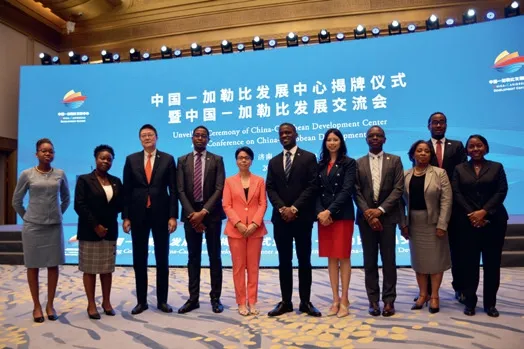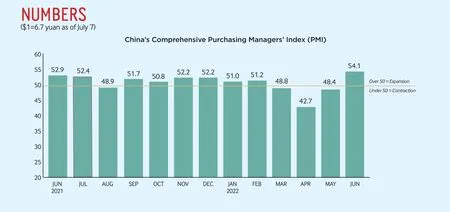THIS WEEK
2022-07-14

THE CARIBBEAN CONNECTION
Inauguration of the China-Caribbean Development Center in Jinan, capital of Shandong Province, on July 6. The center is expected to strengthen China’s cooperation with Caribbean countries.
The event also announced cooperation projects between China and Caribbean nations, including the center’s donation of anti-pandemic materials, collaboration with Guyana on fisheries training, and the launch of an international information exchange platform.
Farming Experiences
Children pick hot peppers to experience agrarian life in a village in Xiangtan City, Hunan Province, on July 4.

Xi’s Book Published
The fourth volume ofhas been published by Foreign Languages Press in both Chinese and English, Xinhua News Agency reported on July 2. The book will be available worldwide.
The latest volume contains a compilation of 109 pieces of spoken and written works of Xi Jinping, General Secretary of the Communist Party of China Central Committee, from February 3, 2020, to May 10 this year along with 45 photographs taken since January 2020. It is divided into 21 sections by topic.
Xi has led the Party and the people in efforts to respond to changes and open up new prospects, while making a penetrating analysis of major theoretical and practical issues concerning the development of the Party and the country, the publisher said.
Employing originality in vision and a wide range of ideas and strategies, Xi has provided answers to questions concerning the present and future of China and its people, as well as the wider world, according to the publisher.
This volume is designed to help officials and the public better understand and apply Xi Jinping Thought on Socialism with Chinese Characteristics for a New Era. It is also intended that this volume will keep the international community abreast of the latest developments in Xi’s thoughts, and explain the development path that China has chosen and its governance approach and theory, the publisher said.
Power Transmission Project
A major part of China’s west-toeast power transmission program kicked off on July 1, a further boost to the nation’s coordination of development between regions.
With its transmission line stretching approximately 2,080 km, the Baihetan-Jiangsu 800-kV ultra-high-voltage (UHV)direct current power transmission project transmits clean hydropower from Baihetan,the world’s second largest hydropower station, in Sichuan Province, to Jiangsu Province.
It is the world’s first UHV direct current power transmission project using a new approach that combines the conventional direct current and flexible direct current technologies, according to the State Grid Corp. of China.
The project has a power transmission capacity of 8 million kW and has the capacity to deliver more than 30 billion kWh of clean electricity annually,helping reduce carbon dioxide emissions by over 25 million tons every year, the company said.
Declining Erosion
China’s water and soil erosion area continued to decrease in 2021, according to the Ministry of Water Resources.
The country’s water and soil erosion area stood at 2.67 million square km in 2021,down 18,500 square km, or 0.69 percent, compared with 2020,according to monitoring data on soil and water loss analyzed by the ministry.
Among the total, the area of hydraulic erosion is 1.11 million square km, down 1.27 percent year on year. The wind erosion area of 1.57 million square km is down 0.27 percent from a year earlier.
The ministry said that in the future it will work with other departments to strictly control water and soil loss caused by human activities, strengthen forest and grassland restoration efforts,and elevate the level of scientific governance to tackle water and soil erosion.
New Highway
A new highway traversing the Taklimakan Desert in Xinjiang Uygur Autonomous Region was put into operation on June 30.
Located in south Xinjiang’s Bayingolin Mongolian Autonomous Prefecture, the highway, connecting Yuli and Qiemo counties, is the third to cross the Taklimakan Desert, the world’s second largest shiftingsand desert.
With the designed speed of 60 or 80 km per hour for different sections, the highway has a total length of 334 km, with 307 km passing through the desert.
Construction of the highway began in October 2017 and total investment on the project is estimated at 1.75 billion yuan ($261.5 million).
Access to Archives
China will grant its public widerranging and more convenient access to national historical archives, the country’s National Archives Administration said.
The administration has recently introduced a set of new guidelines regarding the disclosure of archives to the general public. The new guidelines made stipulations regarding the principles, circumstances and procedure of archive disclosure,as well as how the public can access and use the archives.
According to the guidelines,individuals and organizations with proper credentials can access disclosed archives on-site or via virtual channels including on websites and via e-mail, ensuring streamlined archive access.
In addition, as per China’s new Archives Law enacted in January 2021, foreign individuals and organizations now enjoy equal rights to access disclosed archives in China. The administration reiterated that the disclosure of archives will be carried out in accordance with China’s national security laws.
The guidelines will come into effect on August 1.
Hottest June
The average monthly temperature across China reached 21.3 degrees Celsius in June, the hottest June since 1961, China Meteorological Administration(CMA), the country’s top meteorological agency, said on July 5.
The June temperature was 0.9 degree Celsius higher than usual. Many regions including Henan and Shandong provinces registered the highest June temperature in history, according to the CMA.
Heat waves blanketed parts of China from June 13 to 26,affecting over 600 million people. A county in Hebei Province saw its temperature hit 44.2 degrees Celsius on June 25.
Fang Xiang, Deputy Director of China’s National Meteorological Center, attributed the high temperature to the strong warm high pressure system which controlled north China’s weather during that period.
In July, south China, parts of southwest China and east China
Staying Cool
Children play at a water park in Nanchang, Jiangxi Province, on July 1.

might see lower average temperatures than previous years, while the rest of China might report similar or higher temperatures,according to Fang.
Average Life Expectancy
Chinese people’s average life expectancy has increased to 77.93 years, Mao Qun’an, deputy head of the office responsible for the promotion of the Healthy China initiative, said at a press conference on July 5.
In 2016 when China rolled out the Healthy China 2030 blueprint, the figure was 76.5.
China leads middle and high-income countries in major health indicators, and the targets set for 2020 in the blueprint have largely been achieved, said Mao.Mao said a policy system for health promotion has already taken shape, health risk factors have been brought under effective control, the capacity to provide health services has been substantially improved,and major diseases have been effectively controlled.
Tech Show
Visitors look at cotton automatically packed by a cotton picker during a regional agricultural machinery expo in Urumqi, Xinjiang Uygur
Autonomous Region, on July 3.

Financing Champion
The Chinese A-share market raised 311.9 billion yuan ($46.5 billion) via initial public offerings(IPOs) in the first half of the year,up 46 percent from a year ago and topping the global chart for financing scale, according to data from financial information provider Wind.
In terms of funds raised, the Shanghai and Shenzhen stock exchanges ranked first and second respectively across the world during the period, accounting for nearly half of the global total,Wind data showed.
The boom in the A-share market stood in contrast with the global financial market, which has cooled off after hitting new highs in both the number of IPOs and financing scale last year.
The growth of the A-share market was mainly shored up by the Nasdaq-style sci-tech innovation board (known as the STAR market) on the Shanghai Stock Exchange and the tech-heavy ChiNext market on the Shenzhen Stock Exchange, as well as the return of red chip companies, or companies registered overseas but operate in the Chinese mainland, analysts said.
Enterprises in emerging sectors of strategic importance,including information technology and high-end equipment manufacturing, dominated the IPO list, as they made up over 90 percent of the firms floated on the two bourses during the period.
Digital Economy
The proportion the digital economy contributes to China’s GDP rose from 21.6 percent in 2012 to 39.8 percent in 2021, with its scale increasing from 11 trillion yuan($1.65 trillion) to over 45 trillion yuan ($6.7 trillion) during that period, according to the Ministry of Industry and Information Technology.
The country has built the world’s largest and most technologically advanced network facilities. By the end of May, it had provided full fiberoptic network coverage to all of its prefecture-level cities and established 1.7 million 5G base stations.
China has also accelerated the integration of big data,cloud computing and artificial intelligence with such sectors as energy, healthcare, transportation, education and agriculture.
In 2021, the value-added output of major information technology manufacturers rose 15.7 percent year on year, hitting its highest level in a decade, while the revenues of software and information technology services as well as Internet and related services also registered doubledigit growth, the ministry said.

ETF Trading
Trading of exchange-traded funds (ETFs) under the mainland-Hong Kong stock connect programs began on July 4,marking a significant step toward deepening cooperation between capital markets of both sides.
The inclusion of ETFs in stock connect programs will facilitate investment for both domestic and overseas investors, and help Chinese mainland and Hong Kong asset managers and brokers further improve their management and service, Cai Jianchun, General Manager of the Shanghai Stock Exchange,said at the online launch.
Among the first batch of ETFs included in the stock connect programs, 83 are from the Chinese mainland’s A-share market and four are from the Hong Kong stock market.
As an investment product widely recognized by domestic and overseas investors, ETFs have the advantages of diversified investment, openness, low transaction cost and high efficiency,according to Sha Yan, General Manager of the Shenzhen Stock Exchange.
The inclusion of ETFs will enrich cross-border investment products, provide more investment convenience and opportunities for domestic and overseas investors, and promote the sustained, stable and healthy development of both the Chinese mainland and Hong Kong markets, she added.
Business Profitability
Profitability of Chinese enterprises improved in the second quarter of the year, according to a survey conducted by the People’s Bank of China, the central bank.
The profitability index stood at 51.2 percent, up 2 percentage points from the previous quarter,staying above the 50-mark separating expansion from contraction, according to the survey.
Among the surveyed enterprises, some 31.6 percent said they earned more profit or pared their losses in the April-June period, while 39.3 percent said profits or losses of their firms remained unchanged from the previous quarter.
The business climate index dipped to 48.7 percent from 53.4 percent in the previous quarter.Over 60 percent of the surveyed entrepreneurs deemed conditions “moderate,” while about 17 percent said business operations were “good.”
In this quarterly assessment, over 5,000 industrial enterprises were surveyed in all areas of the country except for Tibet Autonomous Region.The survey contained questions concerning the production, costeffectiveness and investment activities of enterprises.
Rail Freight
Rail cargo volume, a key indicator of economic activity, rose 5.5 percent year on year in the first half of 2022, data from the China State Railway Group Co., Ltd.(China Railway) showed on July 2.
A total of 1.95 billion tons of cargo was transported, 102 million tons more than that in the same period last year, according to the company.
The number of China-Europe freight train trips rose 2 percent year on year to 7,473 in the six months. The trains carried 720,000 twenty-foot equivalent unit containers, up 2.6 percent from a year earlier.
Foreign Investment
In the first five months of the year, China received $47.68 billion in foreign capital for major foreign-funded projects, each with a contracted investment of at least $100 million, up 40.3 percent year on year, data from the Ministry of Commerce showed on June 30.
The sum accounted for 54.3 percent of paid-in foreign investment nationwide during the period, according to the data.Shu Jueting, a spokesperson for the ministry, said at a press briefing that a bevy of global firms have sped up their business expansion in China, which shows an unchanged confidence in the Chinese market and their longterm business prospects in China.
The ministry will continue to ramp up support for major foreign-invested projects and help address difficulties faced by enterprises, she said.
Trade Surplus
China’s international trade in goods and services combined increased 14 percent year on year to 3.75 trillion yuan ($560.2 billion) in May, according to the State Administration of Foreign Exchange.
Exports of goods came in at 1.86 trillion yuan ($278.3 billion) in May, and imports at 1.46 trillion yuan ($218.3 billion),resulting in a surplus of 402.2 billion yuan ($60 billion).
Trade in services saw a deficit of 50.8 billion yuan ($7.6 billion),with the sector’s exports and imports standing at 188 billion yuan($28 billion) and 238.8 billion yuan ($35.6 billion), respectively.
In dollar terms, exports of goods and services trade reached $306.3 billion in May,while imports stood at $253.9 billion, resulting in a surplus of$52.4 billion.

AFGHANISTAN

THE PHILIPPINES

BELARUS

LATVIA

GERMANY

UNITED STATES
The COVID-19 Stigma
July 6
↓ TIANJIN’S NEW MAYOR

Zhang Gong was appointed mayor of Tianjin Municipality, the largest coastal city in north China, on July 6.
Born in 1961 in Beijing, Zhang majored in electrical machinery in college. After graduating in 1983, he was employed by the Beijing Electric Appliance Research Institute and one decade later became its director. In 1997, he obtained a master’s degree in economics.
From 2002 on, he ventured into a political career in Beijing where he was appointed as deputy director of the current Beijing Municipal Bureau of Economy and Information Technology.From 2012 to 2018, he served as the capital’s vice mayor.
On May 31, Zhang was named acting mayor of Tianjin, succeeding Liao Guoxun who died of a sudden illness in office at the age of 59.

Businesses and factories in many places are reopening after China managed to control its recent COVID-19 resurgence. But media reports now indicate that a number of employers are rejecting jobseekers because the latter were once diagnosed with COVID-19.
This kind of discrimination against job applicants is groundless, especially because the chances of recovered cases testing positive again are very low.
Many of these employers are simply protecting their own interests. Under the current circumstances, if an employee relapses, a whole factory will have to shut down. These are realistic worries, but continuing a biased policy against job applicants with blatant disregard for scientific evidence can prove more harmful than the virus itself.
COVID-19 did wreak havoc on businesses, but this is no excuse to deny job applicants an opportunity to get back to work—and back to normal. Particularly not in those places accelerating the reopening of factories.
Beijing’s Urban Renewal

The 77 Theater in Dongcheng District, Beijing,on July 8
July 7
Compared with other cultural parks in Beijing featuring skyscrapers and fancy facilities, the 77 Cultural and Creative Park hidden behind a quaint gray brick street wall in the capital’s Dongcheng District maintains a more common touch.
The 1950s printing-factory-turned-park started renovations in 2012 and went into operation in May 2014, starring film, theater and television drama as its core content. The park’s purposely lowered production costs attract many actors and crews as well as enable audiences to catch a movie or two at a reasonable price.
The 77 Cultural and Creative Park is the epitome of Beijing’s culture-driven urban transition, with more and more of the capital’s old factories now getting a modern makeover.
Dongcheng District has turned a number of its old factories into cultural parks. So far,the district features 42 such parks, covering a total area of 730,000 square meters. Last year,these venues reported a revenue of 143.6 billion yuan ($21.4 billion), setting a successful example for the functional transition of old factories.
Culture is of the utmost importance in any urban overhaul. Under the relevant guidelines rolled out by the Beijing Municipal Government, several cultural parks with distinctive features are on the rise in the city.
These venues not only revitalize the city itself, but also create more space and opportunities for its residents.

Checking up on Green Growth
July 6
In the past seven years, two nationwide inspections on ecology and environment have pushed forward China’s pursuit of greener growth.
The country’s central authorities first started the checks in late 2015 and finished the first round of inspections at the local level by 2018. The second round covered more than 30 provincial-level regions, two government departments, and six centrally administered state-owned enterprises from 2019 to the first half of 2022.
Based on a problem-solving principle,they prioritize the management of both major environmental issues and common public concerns.
So far, 95 percent of the 3,294 problems uncovered during the first round and its review period have been resolved, and half of the 1,227 issues already found in the second round have also been corrected, Vice Minister of Ecology and Environment Zhai Qing said on July 6.
Some 262 cases have been disclosed to the public, of which nearly half relate to pollution and weaknesses in environmental infrastructure; 33.2 percent are in the field of ecology and sustainable development.
↓ LEADING SCREENWRITER AND NOVELIST DIES AT 87

Ni Kuang, one of Hong Kong’s most distinguished screenwriters and novelists, passed away on July 3 at the age of 87.
Born in Shanghai in 1935, Ni moved to Hong Kong in 1957. He was a proofreader and editor, before embarking on a career as a professional writer. He wrote hundreds of novels and film scripts covering different genres, including detective, science fiction, horror, martial arts and romance. He once worked on serializations for 12 newspapers at the same time.
For the 1972 film, he created the protagonist Chen Zhen, portrayed by Bruce Lee. The character went on to become a Chinese cultural icon starring in numerous remakes and adaptations.
Ni received the Lifetime Achievement Award at the Hong Kong Film Awards in 2012.
杂志排行
Beijing Review的其它文章
- Nature’s Remedy Traditional Chinese medicine contributes to global public health governance
- A Trove of Forbidden Treasures Beijing’s Palace Museum gems find a new home in Hong Kong
- A Giant Leap Enhanced capacity-building protects national security
- Inclusive or Exclusive?America’s Indo-Pacific Strategy and its negative implications for regional security and progress
- RIDING THE CLOUD China embarks on big data’s journey to the west
